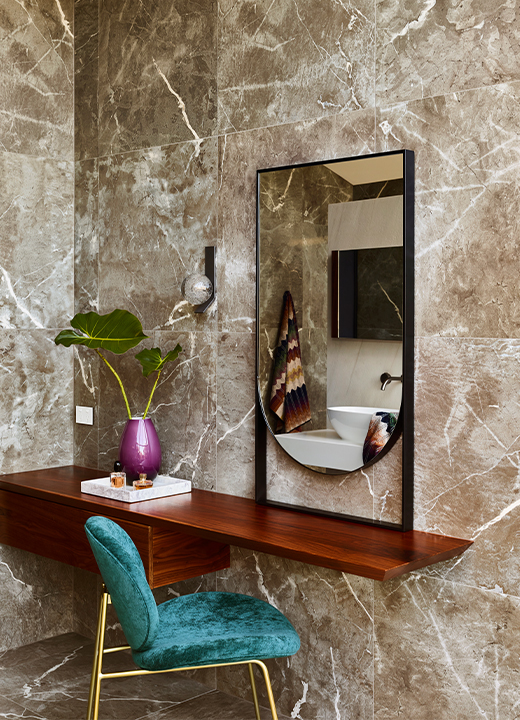
Natural Beauty
Timber remains one of the most practical and popular methods to introduce a natural element into your home’s interior. Whether it acts as a hero piece, or takes a more subtle role in your design, its timeless style is unmatched, complementing almost any element of your space. Katie Livingston chats to Darren James, founder of Darren James Interiors about the benefits of incorporating timber into your kitchen and bathroom, and how you can choose the right product to suit your personal taste.
Since the company’s inception in 2005, Darren James Interiors has favoured the natural, earthy aspect that timber adds to bespoke designs. Both its versatility and variety of colours and grains makes natural timber an enduring solution when it comes to adding character to your kitchen or bathroom.
JACK OF ALL TRADES
While many styles and materials frequently lose their appeal with the eb and flow of new trends, organic materials can be relied upon to look stunning for years to come. “The one trend that never goes out of fashion is a natural product,” James says. One of the true benefits of timber is its design flexibility; whether your theme is modern, classical, provincial or industrial, timber adds warmth and softness to a space. “Timber is very versatile, and it can be used with anything,” James says. “Just do your research on the timber and finishes that can be applied and understand what those finishes can offer you.”

CHOOSE THE RIGHT PRODUCT
Although natural timber is quite versatile in terms of design, it’s important to do your research. Think about what the timber in your home is likely to be exposed to, and take preventative measures to avoid warping or cracking. “One mistake people make is not understanding the nature of timber,” James says. “You have to treat it with respect, understand the characteristics of timber and know where to place it so that it lasts … otherwise it can be a maintenance nightmare.”
Different weather conditions can have a significant impact on your timber’s lifespan. If you live in a humid climate, moisture can cause timber to expand and crack, whereas low humidity can cause your wood to dry out and become brittle.
“Understanding how timber reacts in different climates is very important,” James says. “Timber is going to behave differently in Northern Territory versus a southern state [where] the weather is different.” Being conscious of these external factors will allow you to choose the right product and finish to protect your home. Assess your needs within the space and work closely with your designer or manufacturer to find the perfect product for your kitchen or bathroom.

THE BEST OF BOTH WORLD
To remove the threat of potential damage and maintain that sought-after organic appeal, opt for a timber veneer over natural wood. Available in almost any colour or texture, this option offers more flexibility for highlight pieces and vertical surfaces, without the restrictions of solid timber.
“It’s a great choice for vertical surfaces as it can be more stable compared to natural timber,” James explains. Veneer also requires little maintenance and is less prone to splitting and cracking as a result of changes in weather. This offers a great alternative for bathrooms, which tend to alternate rapidly between dry and humid conditions. On the other hand, working surfaces, like your kitchen bench and dining table, are where solid timber really shines. While timber veneer can be easily scratched or damaged, natural timber is significantly more durable, and allows for more freedom in the shape and style of your fixtures.
STEAL THE SHOW
Whether using timber to create contrast, establish a feature piece or add rustic elements to a modern home, natural wood is your best friend. “We use of a lot of timber as accent pieces and really try and feature it as much as we can,” James agrees. Nothing captures the eye’s attention quite like a timber panel feature wall or grand, natural oak table, but for those seeking a more subtle motif, incorporating small touches of timber into your shelving, kickboards and moulding can really enhance the feeling of warmth in a room.
When it comes to using timber either as a main feature element or as an accent piece, with use in moderation and with purpose. Just by including little details of natural wood here and there you can soften your interiors. If you choose to paint your timber elements to match the colour scheme of your design, you can still achieve the same organic effect simply by choosing a coating that allows the natural woodgrain to show through. “[We’ll often have] a lovely oak product with a beautiful grain, which we’ll paint different colours, and you’ll still get that grain coming out through the colour,” James says. “There’s something really nice about having something a little bit real.” Simply by letting the texture and grain of your timber shine, you can still highlight its natural aspect without deterring from the specific colour palette of your home. James’ final piece of advice is to be open to using natural timber in your home. “It’s always going to look good and will never go out of date,” he says. “The most important thing is to trust your designer and communicate with them what you want.”



